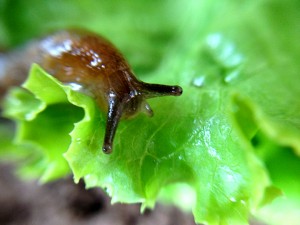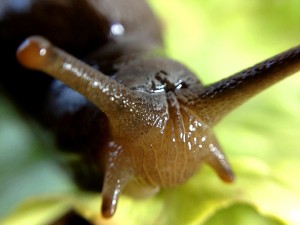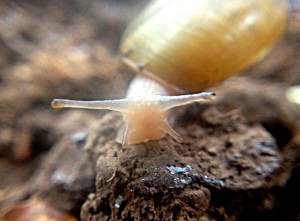13 Answers to our most frequently asked Questions
Q. Where do slugs come from?
A previously slug-free garden can be invaded by the creatures in several ways. Following the “grass is always greener” principle, slugs may make the slow trip over from your neighbor’s yard. Their eggs or the slugs themselves may also stow away in the soil of purchased container plants or in compost or manure brought from outside the garden. If soil conditions are suitable, that is, damp and full of hidey-holes and cracks in which to lay eggs, your new friends will make themselves at home.
Q. What mulch won’t attract slugs?
Fine soil loaded with well broken-down organic matter is unattractive to slugs as it lacks the fine cracks in which to lay eggs. For the same reason, using garden tools that leave a clean smooth surface are a better choice than hoes or rakes that leave egg-receptive creases. Compost with large pieces of bark, sod, or plant matter, such as straw, attract slugs and snails, giving them damp cracks and creases in which to hide and lay eggs. A layer of leaves, if left on top of the soil provides ideal slug habitat – better to till in the leaves to let them break down more rapidly
Mulching with coarse sand or is another option. Although it has little nutrition for plants, it is a rough surface for slugs to travel on and they will sometimes avoid it.
Q. What do slugs eat?
Slugs are not picky eaters. They crawl along the ground munching anything digestible, from decomposing plants to dead animals. In the garden, they may eat tender young plants, bits of compost, fungi, and all sorts of rotting matter, even paper or cardboard. Slugs play an important role in nature, breaking down decaying matter and recycling it back into the soil.
Q. How long does a slug live?
Depending on the species they can live 1 to 5 years..
Q. What is a banana slug?
The banana slug, genus Ariolimax, is the largest land mollusk in North America and can grow as long as 10 inches. It may be green, brown, whitish or yellow and sometimes has dark splotches or spots. Color depends on genetics, light exposure, diet, and environmental moisture.
Three types of banana slugs include the California banana slug, the Pacific banana slug and the slender banana slug.
The California banana slug has a symbiotic relationship with the giant redwood tree, feeding on the seedlings of competing plants and sheltering in the redwood’s hospitably protective and moist environment.
The slender banana slug is named for its narrower “foot.”
Q. What is the difference between a snail and a slug?
Most slugs evolved from snails, losing all or part of their shell over time. The snail has an external shell made of calcium and other minerals. Some slugs retain a remnant shell beneath a soft outer mantle. Theory holds that lack of available calcium and a damp environment contributed to the gradual loss of the shell in damp temperate regions.
When the weather turns hot and dry, a snail can retract into its protective shell to prevent desiccation, while a slug must retreat into the soil or under vegetation to prevent drying out. It is estimated that, during warm summer months, as much as 90% of a garden’s slug population lives underground.
Q. Do lightning bugs eat snails?
Yes! Lightning Bug larvae, which look like beetles, will eat slugs. They have been observed following slime trails and then eating the unlucky slugs. These larvae also consume snails, other insects, and decomposing plants and animals.
Q. What other predators feed on slugs?
Snakes, hedgehogs, raccoons, crows, snakes and some types of beetles all prey on slugs and snails.
Q. Will salt kill slugs?
A slug which has been salted seems to dissolve or melt, but is in fact quickly desiccating, or, having all the water pulled from its usually moist body. Pouring salt on slugs as a way to kill them, however, can be detrimental to garden soil and plants.
Q. What is the least toxic way to rid my garden of slugs?
Picking slugs by hand is probably the least environmentally damaging method of eradication. Arm yourself with a pointy stick, skewer, barbeque fork, or chopsticks and a jar of soapy water.
Early morning is the best time to catch the beasties out, although nighttime hunting with a head-lamp can be rewarding. Search under boards and stepping stones and other dark, moist hiding places. Simply skewer or tweeze the slugs up and drop into the soapy water.
I like to skip the soapy water and dump the jar of slugs into my chicken pen. Yum! Ducks also love to gobble up slugs.
Beer traps are another environmentally friendly way to put a dent in the slug population. Half fill a plastic cottage cheese or margarine container with stale beer or this mixture. Cut half-circle openings in the rim of the container and snap the lid back on. Place the containers near tasty plants in the garden. Slugs will crawl into the container and drown.
Q. How many different gastropod species are there?
There are an estimated 43,000 gastropod species.
Q. Are slugs poisonous?
Not your average garden slug but tropical marine cone snails kill their prey by “harpooning” their prey with a sharp barbed tooth. The barb contains a paralyzing toxin that keeps the prey, usually a fish, from swimming away. The marbled cone snail’s venom is so toxic that one drop could kill more than a dozen people.
The up side to snail venom: scientists are now researching the use of cone snail poisons in treatment of neurological diseases such as epilepsy. Although most toxins used in drugs are extracted from dead snails, some researchers have begun to farm and “milk” the live snails for venom.
Q. Are slugs edible?
Hmmm…probably not a great idea. Snails and slugs can harbor bacteria and parasites that cause diseases in humans, including Angiostrongylus (also called rat lung worm – yuck!). If you must eat a slug, thorough cooking and hand washing will minimize disease risks. We can report that escargot is quite delicious but suspect it has something to do with all that garlic and butter! 😉



